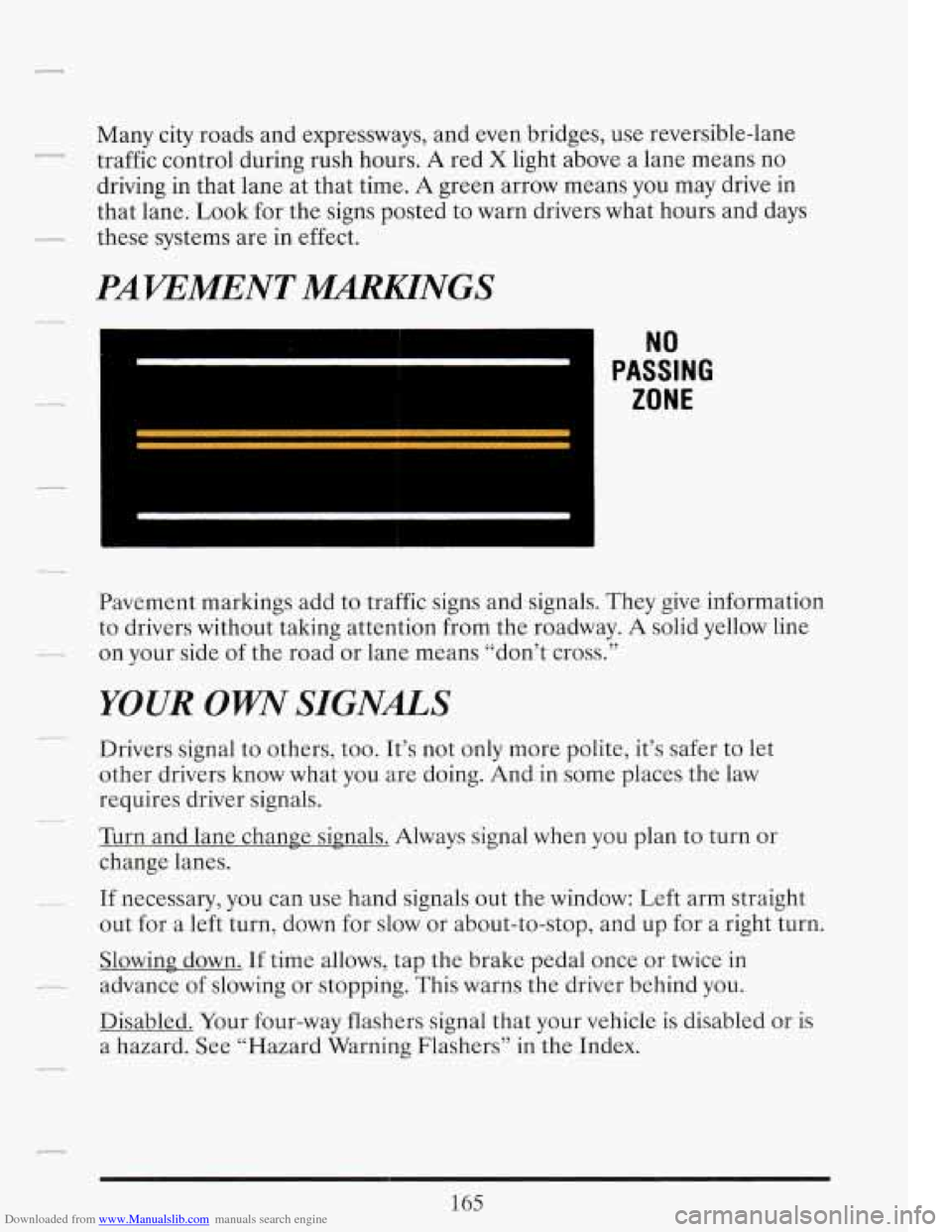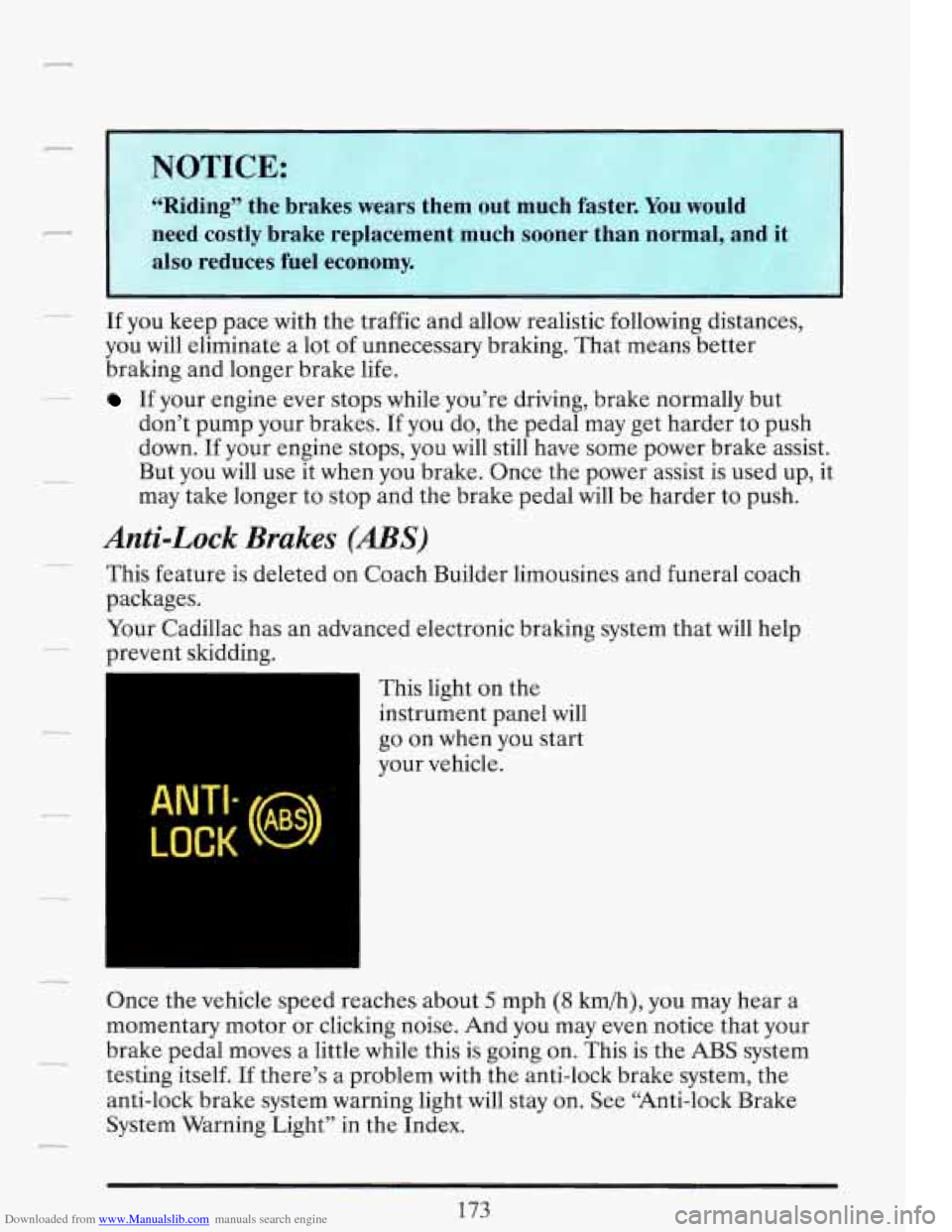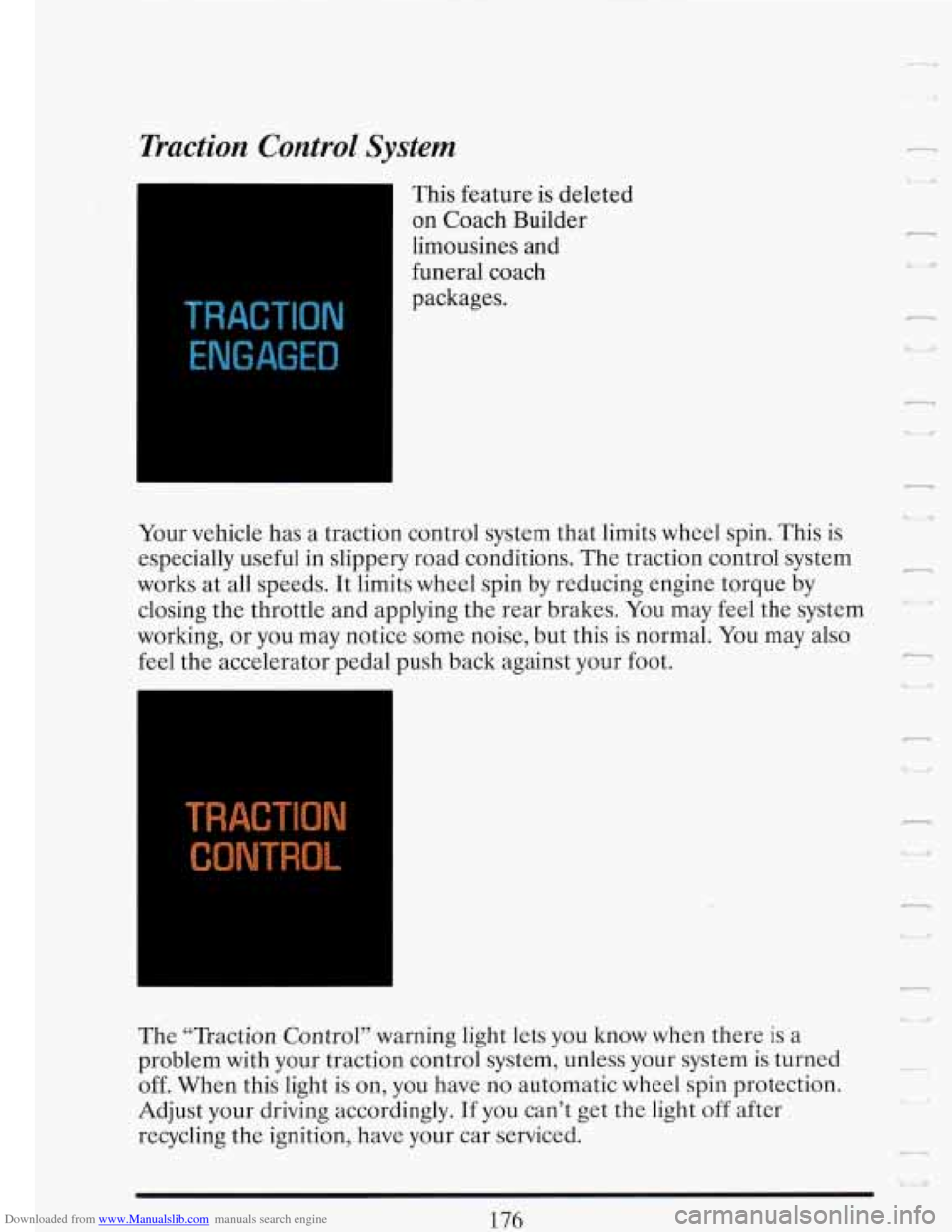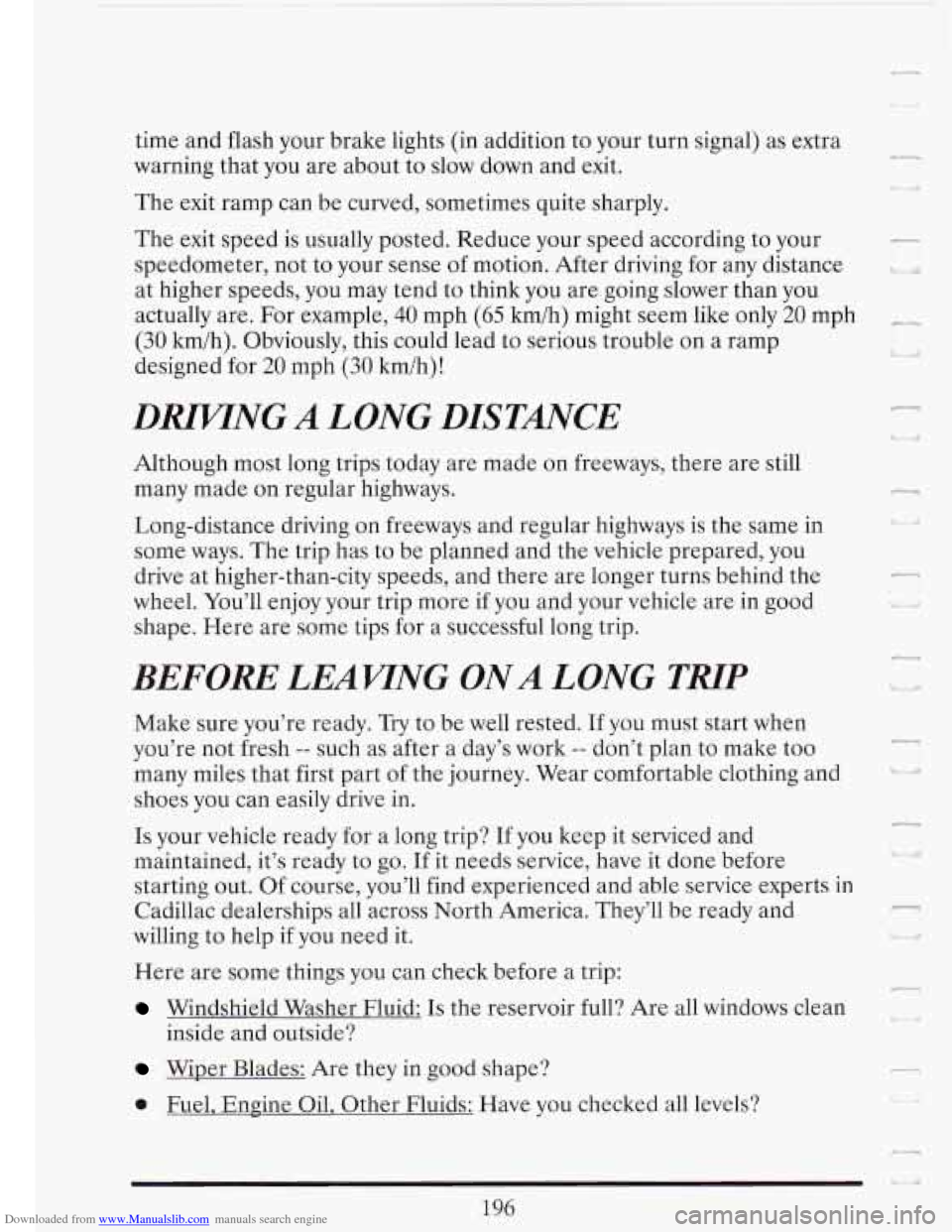Page 179 of 386

Downloaded from www.Manualslib.com manuals search engine Many city roads and expressways, and even bridges, use reversible-lane
traffic control during rush hours.
A red X light above a lane means no
driving in that lane at that time.
A green arrow means you may drive in
that lane.
Look for the signs posted to warn drivers what hours and days
these systems are in effect.
Pavement markings add
to traffic signs and signals. They give information
to drivers without taking attention from the roadway.
A solid yellow line
on your side of the road or lane means “don’t cross.’’
YOUR OWW SIGNALS
Drivers signal to others, too. It’s not only more polite, it’s safer to let
other drivers know what you are doing. And in some places the law
requires driver signals.
Turn and lane change signals. Always signal when you plan to turn or
change lanes.
If necessary, you can use hand signals out the window: Left arm straight
out for a left turn, down for slow or about-to-stop, and up for a right turn.
Slowing down. If time allows, tap the brake pedal once or twice in
advance of slowing or stopping. This warns the driver behind
you.
Disabled. Your four-way flashers signal that your vehicle is disabled or is
a hazard. See “Hazard Warning Flashers” in the Index.
165
Page 187 of 386

Downloaded from www.Manualslib.com manuals search engine If you keep pace with the traffic and allow realistic following distances,
you will eliminate a lot of unnecessary braking. That means better
braking and longer brake life.
If your engine ever stops while you’re driving, brake normally but
don’t pump your brakes.
If you do, the pedal may get harder to push
down.
If your engine stops, you will still have some power brake assist.
But you will use it when you brake. Once the power assist is used up, it
may take longer to stop and the brake pedal
will be harder to push.
Anti-Lock Brakes (ABS)
This feature is deleted on Coach Builder limousines and funeral coach
packages.
Your Cadillac has an advanced electronic braking system that will help
prevent skidding.
This light on the
instrument panel will
go
on when you start
your vehicle.
Once the vehicle speed reaches about
5 mph (8 km/h), you may hear a
momentary motor or clicking noise. And you may even notice that your
brake pedal moves a little while this is going on. This is the
ABS system
testing itself. If there’s
a problem with the anti-lock brake system, the
anti-lock brake system warning light will stay on. See “Anti-lock Brake
System Warning Light” in the Index.
173
Page 190 of 386

Downloaded from www.Manualslib.com manuals search engine Traction Control System
~ This feature is deleted
on Coach Builder
limousines and
funeral coach
packages. I
TRACTION
ENGAGED
Your vehicle has a traction control system that limits wheel spin. This is
especially useful in slippery road conditions. The traction control system
works at all speeds. It limits wheel spin by reducing engine torque by
closing the throttle and applying the rear brakes. You may feel the system
working, or you may notice some noise, but this is normal. You may also
feel the accelerator pedal push back against your foot.
I ~
i
TRACTION
I: I
The “Traction Control” warning light lets you know when there is a
problem with your traction control system, unless your system is turned
off. When this light is on,
you have no automatic wheel spin protection.
Adjust your driving accordingly. If you can’t get the light off after
recycling the ignition, have your car serviced.
n
u
c ‘I W
n
U
I
LrJ
-
L
..
r
1
L 7
I
UI
Page 191 of 386

Downloaded from www.Manualslib.com manuals search engine To limit wheel spin, especially in slippery road conditions, you should
always leave your traction control system on. But you can turn the
traction control system off
if you ever need to.
TRACTION
CONTROL
DISABLE
SWITCH
3
To turn the system off, press this switch. The “Traction Control” light will
come on and stay on. To turn the traction control system back on, you
must stop and turn off the ignition. Then restart the engine. The traction
control system automatically comes on whenever you start your vehicle.
-
Disc Brake Wear Indicators
Your Cadillac has front disc brakes and rear drum brakes.
-- Disc brake pads have built-in wear indicators that make a high-pitched
warning sound when the brake pads are worn and new pads are needed.
The sound may come and go or be heard all the time your vehicle is
.. - moving (except when you are pushing on the brake pedal firmly).
I
A CAUTION:
The brake wear warning sound means that sooner or later your
brakes won’t work well. That could lead to an accident. When
you hear the brake wear warning sound, have your vehicle
serviced. I
Page 207 of 386
Downloaded from www.Manualslib.com manuals search engine One of the biggest problems with city streets is the amount of traffic on
them. You’ll want to watch out for what the other drivers are doing and
pay attention to traffic signals.
Here are ways to increase your safety in city driving:
---
0
.-._- 0
Know the best way to get to where you are going. Try not to drive
around trying to pick
out a familiar street or landmark. Get a city map
and plan your trip into an unknown part of the city just as
you would
for a cross-country trip.
Try to use the freeways that rim and crisscross most large cities. You’ll
save time and energy. (See the next section, “Freeway Driving.”)
Treat a green light as a warning signal.
A traffic light is there because
the corner is busy enough to need it. When a light turns green, and
just before you start to move, check both ways for vehicles that have
not cleared the intersection or may be running the red light.
193
Page 210 of 386

Downloaded from www.Manualslib.com manuals search engine time and flash your brake lights (in addition to your turn signal) as extra
warning that you are about to slow down and exit.
The exit ramp can be curved, sometimes quite sharply.
-.
U t I! The exit speed is usually posted. Reduce your speed according to your
speedometer, not to your sense
of motion. After driving for any distance
at higher speeds, you may tend to think you are going slower than you
actually are. For example,
40 mph (65 h/h) might seem like only 20 mph c_?
(30 km/h). Obviously, this could lead to serious trouble on a ramp
designed for
20 mph (30 kmih)!
I
L/
DRIVTNG A LONG DISTANCE
Although most long trips today are made on freeways, there are still
many made on regular highways.
Long-distance driving on freeways and regular highways is the same in
some ways. The trip has
to be planned and the vehicle prepared, you
drive at higher-than-city speeds, and there are longer turns behind the
wheel. You’ll enjoy your trip more if you and your vehicle are in good
shape. Here are some tips for a successful long trip.
BEFORE LEAWNG ONA LONG TRlP
Make sure you’re ready. Try to be well rested. If you must start when
you’re not fresh
-- such as after a day’s work -- don’t plan to make too
many miles that first part of the journey. Wear comfortable clothing and
shoes you can easily drive in.
.3
I
F i ! u
Is your vehicle ready for a long trip? If you keep it serviced and
maintained, it’s ready to
go. If it needs service, have it done before
starting out. Of course, you’ll find experienced and able service experts in
Cadillac dealerships all across North America. They’ll be ready and
7
willing to help if you need it. -1
Here are some things you can check before a trip:
Windshield Washer Fluid: Is the reservoir full? Are all windows clean
inside and outside?
Wiper Blades: Are they in good shape?
0 Fuel, Engine Oil, Other Fluids: Have you checked all levels?
Page 218 of 386
Downloaded from www.Manualslib.com manuals search engine 4
n
Include an ice scraper, a small brush or broom, a supply of windshield
washer fluid, a rag, some winter outer clothing, a small shovel, a
flashlight, a red cloth, and a couple of reflective warning triangles. And,
if ' -
you will be driving under severe conditions, include a small bag of sand, a
piece of old carpet or a couple of burlap bags to help provide traction. Be
-
sure you properly secure these items in your vehicle.
n
Driving on Snow or Ice F
Most of the time, those places where your tires meet the road probably
have good traction.
However,
if there is snow or ice between your tires and the road, you can
have a
very slippery situation. You'll have a lot less traction or "grip" and
will need
to be very careful.
c_
204
Page 231 of 386
Downloaded from www.Manualslib.com manuals search engine -- I
I
- Your hazard warning flashers let you warn others. They also let police
know you have a problem. Your front and rear turn signal lights will flash
on and
off.
Press the button in to
make your front and
rear turn signal lights
flash on and
off.
Your hazard warning flashers work no matter what position your key is in,
and even if the key isn’t in.
iI